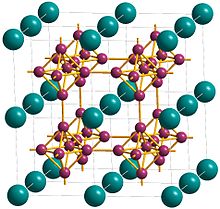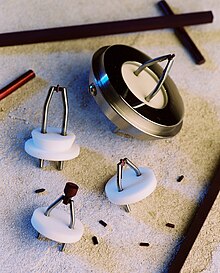Lanthanum hexaboride
 | |
| Names | |
|---|---|
| Other names Lanthanum boride | |
| Identifiers | |
CAS Number |
|
| ChemSpider |
|
| ECHA InfoCard | 100.031.379 |
| EC Number |
|
PubChem CID |
|
CompTox Dashboard (EPA) |
|
InChI
| |
| Properties | |
Chemical formula | LaB6 |
| Molar mass | 203.78 g/mol |
| Appearance | intense purple violet |
| Density | 4.72 g/cm3 |
| Melting point | 2,210 °C (4,010 °F; 2,480 K) |
Solubility in water | insoluble |
| Structure | |
Crystal structure | Cubic |
Space group | Pm3m ; Oh |
Except where otherwise noted, data are given for materials in their standard state (at 25 °C [77 °F], 100 kPa).  Y verify (what is Y verify (what is  Y Y N ?) N ?) Infobox references | |



Lanthanum hexaboride (LaB6, also called lanthanum boride and LaB) is an inorganic chemical, a boride of lanthanum. It is a refractory ceramic material that has a melting point of 2210 °C, and is insoluble in water and hydrochloric acid. It is extremely hard, with a Mohs hardness of 9.5.[1] It has a low work function and one of the highest electron emissivities known, and is stable in vacuum. Stoichiometric samples are colored intense purple-violet, while boron-rich ones (above LaB6.07) are blue. Ion bombardment changes its color from purple to emerald green.[2] LaB6 is a superconductor with a relatively low transition temperature of 0.45 K.[3]
Uses
Electron Sources
The principal use of lanthanum hexaboride is in hot cathodes, either as a single crystal or as a coating deposited by physical vapor deposition. Hexaborides, such as lanthanum hexaboride (LaB6) and cerium hexaboride (CeB6), have low work functions, around 2.5 eV. They are also somewhat resistant to cathode poisoning. Cerium hexaboride cathodes have a lower evaporation rate at 1700 K than lanthanum hexaboride, but they become equal at temperatures above 1850 K.[4] Cerium hexaboride cathodes have one and half the lifetime of lanthanum hexaboride, due to the former's higher resistance to carbon contamination. Hexaboride cathodes are about ten times "brighter" than tungsten cathodes, and have 10–15 times longer lifetime. Devices and techniques in which hexaboride cathodes are used include electron microscopes, microwave tubes, electron lithography, electron beam welding, X-ray tubes, free electron lasers and several types of electric propulsion technologies. Lanthanum hexaboride slowly evaporates from the heated cathodes and forms deposits on the Wehnelt cylinders and apertures.
X-Ray Diffraction Reference
LaB6 is also used as an X-ray powder diffraction (XRD or pXRD) peak position and line shape reference standard.[5] It is therefore used to calibrate measured diffractometer angles and to determine instrumental broadening of diffraction peaks. The latter makes crystallite size and strain measurements by XRD possible.[6]
References
- ^ Schmidt, Kevin (2014). Computational Modeling of Lanthanum Hexaboride Materials: Interatomic Potentials and Molecular Dynamics (PDF) (Master of Science). University of Nevada, Reno. Retrieved 15 April 2022.
Lanthanum hexaboride has a hardness of ≈ 9.5, similar to B4C and between corundum (Al2O3) and diamond on the low and high ends of the Mohs scale, respectively.
- ^ T. Lundström (1985). "Structure, defects and properties of some refractory borides" (PDF). Pure and Applied Chemistry. 57 (10): 1383–1390. doi:10.1351/pac198557101383. S2CID 93184983.
- ^ G. Schell; H. Winter; H. Rietschel; F. Gompf (1982). "Electronic structure and superconductivity in metal hexaborides". Phys. Rev. B. 25 (3): 1589–1599. Bibcode:1982PhRvB..25.1589S. doi:10.1103/PhysRevB.25.1589.
- ^ "Comparing Lanthanum Hexaboride (LaB6) and Cerium Hexaboride (CeB6) Cathodes". Retrieved 2009-05-05.
- ^ "National Institute of Standards & Technology Certificate Standard Reference Material 660c Line Position and Line Shape Standard for Powder Diffraction (Lanthanum Hexaboride Powder)" https://tsapps.nist.gov/srmext/certificates/660c.pdf
- ^ C. T. Chantler; C. Q. Tran; D. J. Cookson (2004). "Precise measurement of the lattice spacing of LaB6 standard powder by the x-ray extended range technique using synchrotron radiation". Phys. Rev. A. 69 (4): 042101. Bibcode:2004PhRvA..69d2101C. doi:10.1103/PhysRevA.69.042101.











